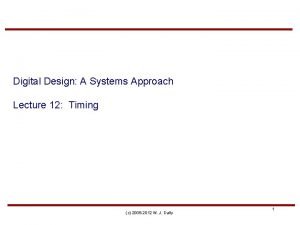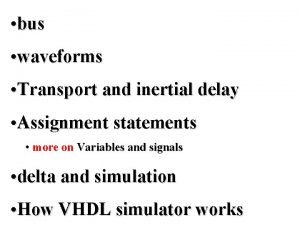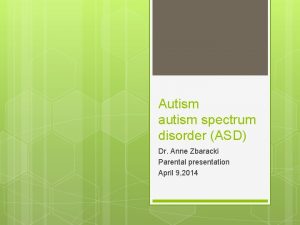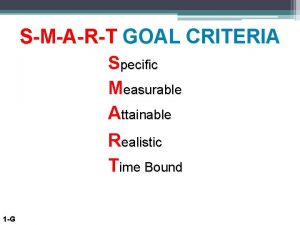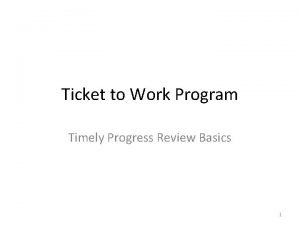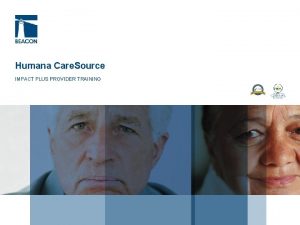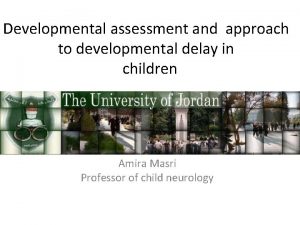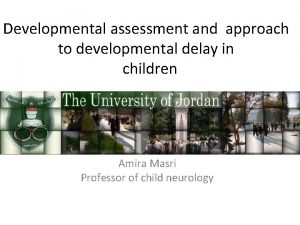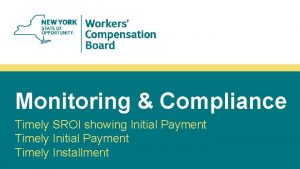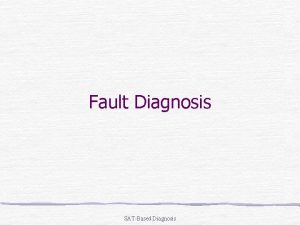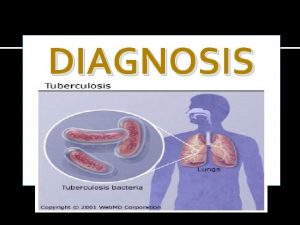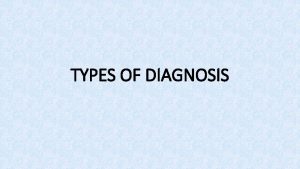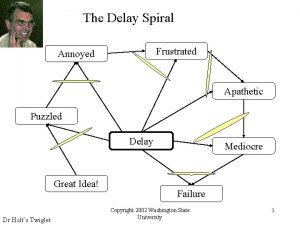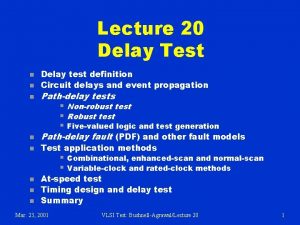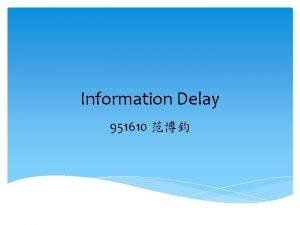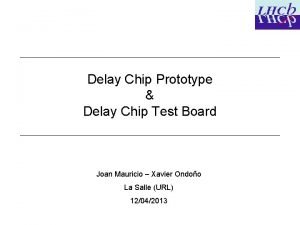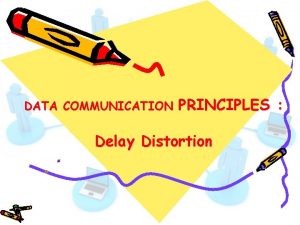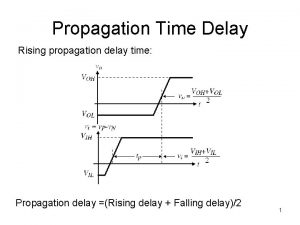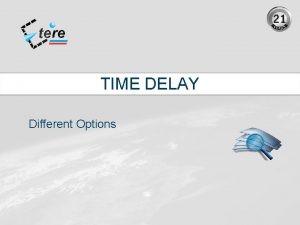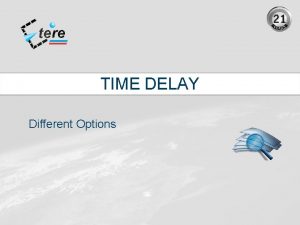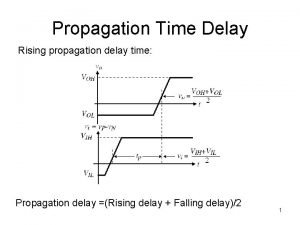The Timely Diagnosis of Developmental Delay Karen MontgomeryReagan









































- Slides: 41

The Timely Diagnosis of Developmental Delay Karen Montgomery-Reagan, D. O. FACOP, FAAP Ohio University Heritage College of Osteopathic Medicine Department of Pediatrics

Developmental delay occurs when a child exhibits a significant delay in the acquisition of milestones. Deviation in development is 2 • A. child has differing rates of development in different developmental domains • • • B. child loses previously acquired skills or milestones C. child has a delay in two or more domains D. child develops milestones outside of typical acquisition sequence

Identify the incorrect statement 3 • A. 66% of the children entering school are identified with a delay • B. 5% of world’s children under age of 14 have some type of moderate to severe developmental delay • C. 16 -18% of children in US have a developmental/behavioral problem under 18 years of age • D. Development impairment impacts the family and community

Objectives 4 • Understand reasoning for timely developmental diagnosis • Understand the difference between screening and surveillance • Introduce use of screening tools in the primary care office

PCP is the point of “first contact” for any new health concerns 5 • Developing a therapeutic relationship with my patients; treating several generations within a family and following patients over many years; counseling patients“ • Having the implicit trust of my patients to direct their [preventive] care and treat their diseases. The privilege of having families count on me as one of their own and especially to share the growing up of their children. ” • Articles from Canadian Family Physician are provided here courtesy of College of Family Physicians of Canada

Who Says What 6 • • • USPSTF -- neither recommends for or against use of screening tools • Center for Disease Control and Prevention recommends the use of a brief developmental assessment to identify children who should receive intensive diagnosis or evaluation (2005) • AAP –- recommends surveillance combined with standardized screening at well-child visits. AAFP -- is in agreement with the USPSTF needing evidence The Individuals with Disabilities Education Act Amendments of 1997 and Title V of Social Security Act -- mandate that health care professionals provide early identification and intervention for development delay working with community collaborative systems

Childhood Development 7 • Trajectory of achieving physical, cognitive, communications, social-emotional, and self-help milestones within a specific age range. • Delays – childhood mental or physical impairment or combination of mental and physical impairment that result in functional limitations in major life activities • Developmental disabilities – impairment in one or more developmental domains

Definitions 8 • Global Delay – a delay in 2 or more developmental delays • Deviations – occurs when a child develops milestone/skill outside of typical sequence • Dissociation – occurs when a child has widely differing rates of development in different domains • Regression – child loses acquired skills or milestones

Early Identification of Children with Developmental Delay 9 • 12 -16% of children in the United States have at least one development delay • • • Only 3% will be diagnosed before 3 years of age Only 1/3 by time the child enters kindergarten Late detection results in opportunity lost for “early intervention”

What does late detection mean for the child, parent and society • Early interventions • • • 10 Improvement in language/communication Cognitive Social-emotional Family better able to meet the needs of the child Decreased need for costly special education services

Barriers for primary care • • 11 Cost Lack of time Reimbursement Insufficient training Over identification concern Availability of referral options Limited services in the community

Coordinated Systems of Health Care • • In the End • Substantial opportunities exist to help monitor the development of child in the US • • 12 The USPSTF states -- it is ultimately the responsibility of the physician to seek out and address parental concerns about their child’s development Protocols for developmental monitoring Use of validated developmental screening tools

Medical Home • Parents’ expectation of their child’s medical home Continuous and comprehensive care – Identify abnormality in development – Be knowledgeable of community resources – Facilitate referrals – • 13 AAP: Bright Futures: guidelines for health supervision of infants, children and adolescents

Bright Futures 14

Surveillance vs Screening • Developmental Surveillance • • Developmental Screening • 15 Recognizing children who may be at risk of developmental delays Administration of a brief standardized tool for possible identification of child at risk of a developmental disorder

Components of Surveillance • • • 16 Eliciting and attending to the parents’ concerns about their child’s development Documenting and maintaining a development history Making accurate observations of the child Identifying the risk and protective factors Maintaining an accurate record and documenting the process and findings

Recommendation from the AAP 17 • • Developmental Surveillance at every well-child visit • When a parent or provider has concern then formal screening performed Developmental Screening using formal, validated tools at 9, 18, 30 (24)

General Screening Tools • Ages and stages questionnaire (ASQ-3) • Ages and stages questionnaire: Social-Emotional (ASG validated -SE 2) • • Parents' Evaluation of Developmental Status (PEDS) • • Modified checklist for Autism in Toddlers (M-Chat-R/F) Parents’ Evaluation of developmental status. Development Milestones (Peds-DM) Patient Health Questionnaire-9 (PHQ-9) Edinburgh Postnatal Depression scale Hunger Vital Sign https: //www. aap. org/en-us/about-the-aap/Committees-Councils-Sections/Council-on-Children-with. Disabilities/Pages/Description-and-Policy. aspx 18

Administration of Development Tool • Two types of formal screening tools Parent-Completed • Parent completes the questionnaire • Time efficient and reduce cost • 5 -10 minutes for parent to complete • Directly administered • Direct observation and parent input • In-Depth information • Useful as secondary stage screening • 19

Ages and Stages Questionnaires 20

Administration of Development Tool • Ages and Stages Questionnaire (ASQ) 21 age-specific questionnaires • Five developmental domains • • 21 Fine and gross motor, language/communication, problem solving/adaptive behavior, personal/social preformation 6 items in each area Section of 10 questions to query parental concern 4 -6 grade reading level Takes 1 -5 minutes to score Specificity 86%; Sensitivity 85%; reliability 0. 94 Agesandstages. com

22

23

24

https: //www. cdc. gov/ncbddd/childdevelopment/screening-hcp. html 25

https: //www. aap. org/en-us/about-the-aap/Committees-Councils-Sections/Council-on-Children-with. Disabilities/Pages/Description-and-Policy. aspx 26

No “wait and see” approach 27 • Children who pass screening provides an opportunity to promote developmentally appropriate activities and discuss future milestones • Children wo fail screening need close follow up or further testing • Early intervention referral should not be delayed or know as “wait and see” • Early treatment improves the quality of life for child and parents and less costly to society

Why 9 18 and 30 (24) month screen? 28 • 9 months – issues with motor skills identified and early communication skills • 18 months – issues with communication and language are evident by this age • 30 months – most motor, language, cognitive delays identified with screening tools • Remember through surveillance that screenings should be administered if concerns raised by parents, PCP, or other care givers

Abnormal Screen Evaluation and Referral • • • 29 Comprehensive Medical Evaluation Early Childhood Professionals Pediatric subspecialists Early intervention programs Public school special education (3 year old)

Medical Home Interdisciplinary Team • • 30 Provider Childhood educators Child psychologist Speech-language pathologists Audiologists Social workers Physical therapists Occupational therapists

Evaluation and Referral • Primary Care Tests • • • 31 Vision and hearing Metabolic testing Lead and iron level Genetic testing EEG Brain imaging

Diagnostic Developmental Testing • • • 32 Bayley Scales of Infant and Toddler Development Woodcock-Johnson Psychoeducational Stanford-Binet intelligence scale Battellle Developmental Inventory Brigance System

Developmental Disorder 33 • Child with special health care needs which initiates chronic-condition management • Medical Home should recognize and provide appropriate chronic-condition management with regular monitoring • Medical Home develops a registry for children in the practice who have special care needs • Medical Home provides a triad of primary care services: preventative care, acute illness management and chronic-condition management

Incorporating Screening in the office of Primary Care • • 34 Use a quality-improvement approach Developmental screening is “whole-office” endeavor

Screening Payment • CPT codes Developmental screening limited -- 96110 – Developmental testing extended -- 96111 – • 35 Medicare Resource Based Relative Value Scale -codes and reflect physician work, practice expenses

Screening Payment, cont’d. 36 CPT Code Tests it Includes Reimbursement 96127 ASQ-SE, PHQ-9, Conners $4. 21 to $7. 29 96161 EPDS $4. 07 to $5. 18 96110 M-Chat and ASQ $3. 75 to $9. 62

37

38

39

Summary 40 • • Surveillance -- component of every visit • • Screening positive – further testing is warranted Screening tools – surveillance identifies a concern and at 9, 18, and 30 month visit Children with developmental disorders identified with special health care needs – chronic-condition management

Citations 41 • American Academy of Pediatrics; Council on Children with Disabilities, Section on Developmental Behavioral Pediatrics, Bright Futures Steering Committee and Medical Home Initiatives for Children with Special Needs Project Advisory Committee. (2006). Identifying Infants and Young Children with Developmental Disorders in the Medical Home: An Algorithm for Developmental Surveillance and Screening. Pediatrics, 118(1), 405 -420. doi: 10. 1542/peds. 2006 -1231 • Division of Human Development and Disabilities, National Center on Birth Defects and Developmental Disabilities, Centers for Disease Control and Prevention. (2018). Developmental Monitoring and Screening for Health Professionals. Retrieved from https: //www. cdc. gov/ncbddd/childdevelopment/screening-hcp. html
 Propagation delay and contamination delay
Propagation delay and contamination delay Assignment statement
Assignment statement Plc timer symbol
Plc timer symbol Global developmental delay symptoms
Global developmental delay symptoms Specific measurable attainable realistic timely
Specific measurable attainable realistic timely The process of attracting individuals on a timely basis
The process of attracting individuals on a timely basis Editorial introduction example
Editorial introduction example Naiad dataflow
Naiad dataflow Timely progress
Timely progress Caresource timely filing limit
Caresource timely filing limit Nursing process and critical thinking
Nursing process and critical thinking Ongoing planning in nursing process
Ongoing planning in nursing process Perbedaan diagnosis gizi dan diagnosis medis
Perbedaan diagnosis gizi dan diagnosis medis Medical diagnosis and nursing diagnosis difference
Medical diagnosis and nursing diagnosis difference Second phase of nursing process
Second phase of nursing process đại từ thay thế
đại từ thay thế Diễn thế sinh thái là
Diễn thế sinh thái là Vẽ hình chiếu vuông góc của vật thể sau
Vẽ hình chiếu vuông góc của vật thể sau Công thức tiính động năng
Công thức tiính động năng Thế nào là mạng điện lắp đặt kiểu nổi
Thế nào là mạng điện lắp đặt kiểu nổi Tỉ lệ cơ thể trẻ em
Tỉ lệ cơ thể trẻ em Lời thề hippocrates
Lời thề hippocrates Vẽ hình chiếu đứng bằng cạnh của vật thể
Vẽ hình chiếu đứng bằng cạnh của vật thể Phản ứng thế ankan
Phản ứng thế ankan Quá trình desamine hóa có thể tạo ra
Quá trình desamine hóa có thể tạo ra Kể tên các môn thể thao
Kể tên các môn thể thao Hình ảnh bộ gõ cơ thể búng tay
Hình ảnh bộ gõ cơ thể búng tay Khi nào hổ mẹ dạy hổ con săn mồi
Khi nào hổ mẹ dạy hổ con săn mồi điện thế nghỉ
điện thế nghỉ Các loại đột biến cấu trúc nhiễm sắc thể
Các loại đột biến cấu trúc nhiễm sắc thể Nguyên nhân của sự mỏi cơ sinh 8
Nguyên nhân của sự mỏi cơ sinh 8 Trời xanh đây là của chúng ta thể thơ
Trời xanh đây là của chúng ta thể thơ Chó sói
Chó sói Thiếu nhi thế giới liên hoan
Thiếu nhi thế giới liên hoan Fecboak
Fecboak Một số thể thơ truyền thống
Một số thể thơ truyền thống Thế nào là hệ số cao nhất
Thế nào là hệ số cao nhất Lp html
Lp html Hệ hô hấp
Hệ hô hấp Tư thế ngồi viết
Tư thế ngồi viết Bảng số nguyên tố lớn hơn 1000
Bảng số nguyên tố lớn hơn 1000 đặc điểm cơ thể của người tối cổ
đặc điểm cơ thể của người tối cổ
